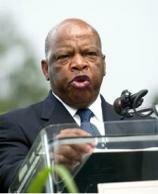Nate Powell Discusses March
Nate Powell takes us inside the creation of the artwork for March.
How did you get involved with March?
In early 2011, I saw Top Shelf’s press release about signing March sans artist—the book sounded really exciting, but I was super busy finishing up Any Empire and The Silence of Our Friends, and about to jump straight into The Year of the Beasts, so I just kept my nose to the drawing table. A few weeks later, Chris Staros gave me a call suggesting that I try out for the artist position, so I took a few pages from the script and submitted demo comic pages to Congressman Lewis and Andrew. We very quickly built up a good relationship, and they ultimately decided on me for the project.
How did you and Rep. John Lewis, along with cowriter Andrew Aydin, collaborate on the project? How much time did you all spend physically together to create the book?
Before I ever came on board, John and Andrew had spent a few years working up the script together. It was initially a single 150-to-200-page graphic novel, but once I started breaking down the script according to my own narrative sensibilities, I realized very quickly that we were dealing with a 450-page epic. Over the summer of 2012, we decided to break the story into a trilogy rather than begin the dubious (and questionable) task of whittling away at the content of such a crucial story. It’s been a very even and open collaboration on every level. At points I definitely took more of a narrative lead in Book One, but their writing has adapted and evolved accordingly with subsequent volumes to reflect the collaborative organism. I met Andrew in person during San Diego Comic Con 2012 and met with Congressman Lewis for the first time just before the 2012 Small Press Expo. We all attended an amazing pilgrimage to various civil rights landmarks in Alabama this March and have been hanging out on almost a weekly basis throughout the summer and fall—it’s been intense! A lot of that time together plays a huge part in the production of Books Two and Three.
Were you surprised that Lewis wanted to share this story as a graphic work? In your view, was it a challenge to turn this memoir into a comic?
The decision made perfect sense to me. I mean, I live and breathe comics and enjoy them in their boundless potential and applications. It seemed like a natural choice. As I got started breaking down the script, I read John Lewis’ incredibly powerful memoir, Walking With the Wind. I was relieved to find that, despite the content of the two books being so similar (being the same person’s life story), there were huge differences in approach, tone, focus, and context. I also spent childhood in Alabama, about 50 miles from where John Lewis grew up, and though I had a very different experience growing up, largely due to middle class white privilege, I was still able to draw heavily on my own memories of life in the South, of its environment and culture. Congressman Lewis and I both grew up with a certain gravity filling our internal landscapes. We were intense kids.
While the story of March is a peaceful one, there is much violence and much that had to be overcome. What was the hardest part of the book for you to illustrate, the part you had the most difficulty conveying?
The most difficult passage was definitely the one-page depiction of the murder of Emmett Till, particularly the rendering of Till’s body being pulled out of the river. Working from various funeral and police photos, I tried to balance an unflinching rendering of his mutilated corpse, while allowing enough economy of line to let the reader identify Till’s body as that of a teenager that they might’ve known. That was the only time in Book One where I had to call it quits for the day after drawing a panel, though not just because of the rendering. I did my own research to verify a few things, discovering that Till’s murderers admitted to killing him in an interview just a few months later, and that at least one of the s--tbags was (possibly) still alive, living in Kentucky.
Conversely, which part made you the happiest to illustrate?
My favorite moment in Book One is actually the Woolworth’s sit-in featuring the first explicit physical violence against the activists, as well as John Lewis’ first arrest. His depiction of crossing over a threshold of conviction, of being liberated by his actions, of the power in their transcendence on that day, amidst being beaten, harassed, and jailed --- it was magical.
Have you already started working on the sequel to this book?
Oh, yes! The script to the whole trilogy is nearly complete --- they’re just ironing out a few more things after our creative relationship came to fruition. I’m currently penciling Book Two, which should be out at the very end of 2014.
Did you travel to the sites in Lewis’s story to be able to better depict them? How did you manage to capture the look and feel of the times in your artwork?
I didn’t actually get a chance to visit the Nashville sites before finishing up the artwork, but did manage to spend time throughout Alabama’s landmarks that appear in the book. I often drew on my own memories growing up in Alabama, Mississippi, and Arkansas, and tried to allow those their place in the narrative without unnecessary anxiety --- after all, the South isn’t a myth, it’s a region. I do daily research and referencing to cover all the bases, though --- a balance between Google image search, a variety of photography books covering the Movement, 1960’s fashion illustration books, written accounts, news footage and videos, John Lewis’ own accounts (either verbally or in his memoir), and a healthy amount of general questions directed towards my parents, being Mississippian baby boomers just a few years younger than John.









